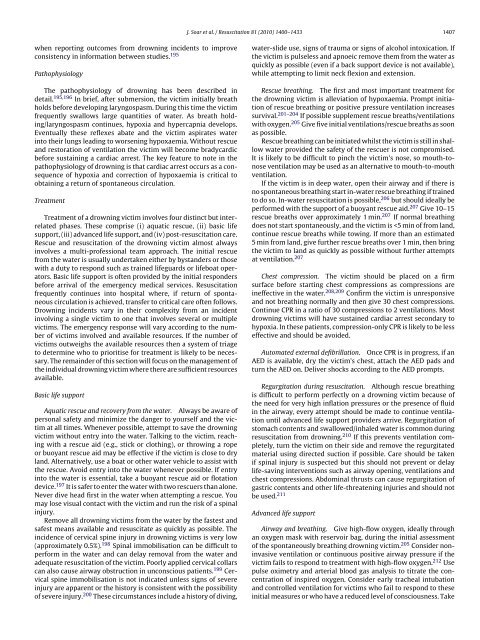European Resuscitation Council Guidelines for Resuscitation 2010 ...
European Resuscitation Council Guidelines for Resuscitation 2010 ...
European Resuscitation Council Guidelines for Resuscitation 2010 ...
You also want an ePaper? Increase the reach of your titles
YUMPU automatically turns print PDFs into web optimized ePapers that Google loves.
J. Soar et al. / <strong>Resuscitation</strong> 81 (<strong>2010</strong>) 1400–1433 1407<br />
when reporting outcomes from drowning incidents to improve<br />
consistency in in<strong>for</strong>mation between studies. 195<br />
Pathophysiology<br />
The pathophysiology of drowning has been described in<br />
detail. 195,196 In brief, after submersion, the victim initially breath<br />
holds be<strong>for</strong>e developing laryngospasm. During this time the victim<br />
frequently swallows large quantities of water. As breath holding/laryngospasm<br />
continues, hypoxia and hypercapnia develops.<br />
Eventually these reflexes abate and the victim aspirates water<br />
into their lungs leading to worsening hypoxaemia. Without rescue<br />
and restoration of ventilation the victim will become bradycardic<br />
be<strong>for</strong>e sustaining a cardiac arrest. The key feature to note in the<br />
pathophysiology of drowning is that cardiac arrest occurs as a consequence<br />
of hypoxia and correction of hypoxaemia is critical to<br />
obtaining a return of spontaneous circulation.<br />
Treatment<br />
Treatment of a drowning victim involves four distinct but interrelated<br />
phases. These comprise (i) aquatic rescue, (ii) basic life<br />
support, (iii) advanced life support, and (iv) post-resuscitation care.<br />
Rescue and resuscitation of the drowning victim almost always<br />
involves a multi-professional team approach. The initial rescue<br />
from the water is usually undertaken either by bystanders or those<br />
with a duty to respond such as trained lifeguards or lifeboat operators.<br />
Basic life support is often provided by the initial responders<br />
be<strong>for</strong>e arrival of the emergency medical services. <strong>Resuscitation</strong><br />
frequently continues into hospital where, if return of spontaneous<br />
circulation is achieved, transfer to critical care often follows.<br />
Drowning incidents vary in their complexity from an incident<br />
involving a single victim to one that involves several or multiple<br />
victims. The emergency response will vary according to the number<br />
of victims involved and available resources. If the number of<br />
victims outweighs the available resources then a system of triage<br />
to determine who to prioritise <strong>for</strong> treatment is likely to be necessary.<br />
The remainder of this section will focus on the management of<br />
the individual drowning victim where there are sufficient resources<br />
available.<br />
Basic life support<br />
Aquatic rescue and recovery from the water. Always be aware of<br />
personal safety and minimize the danger to yourself and the victim<br />
at all times. Whenever possible, attempt to save the drowning<br />
victim without entry into the water. Talking to the victim, reaching<br />
with a rescue aid (e.g., stick or clothing), or throwing a rope<br />
or buoyant rescue aid may be effective if the victim is close to dry<br />
land. Alternatively, use a boat or other water vehicle to assist with<br />
the rescue. Avoid entry into the water whenever possible. If entry<br />
into the water is essential, take a buoyant rescue aid or flotation<br />
device. 197 It is safer to enter the water with two rescuers than alone.<br />
Never dive head first in the water when attempting a rescue. You<br />
may lose visual contact with the victim and run the risk of a spinal<br />
injury.<br />
Remove all drowning victims from the water by the fastest and<br />
safest means available and resuscitate as quickly as possible. The<br />
incidence of cervical spine injury in drowning victims is very low<br />
(approximately 0.5%). 198 Spinal immobilisation can be difficult to<br />
per<strong>for</strong>m in the water and can delay removal from the water and<br />
adequate resuscitation of the victim. Poorly applied cervical collars<br />
can also cause airway obstruction in unconscious patients. 199 Cervical<br />
spine immobilisation is not indicated unless signs of severe<br />
injury are apparent or the history is consistent with the possibility<br />
of severe injury. 200 These circumstances include a history of diving,<br />
water-slide use, signs of trauma or signs of alcohol intoxication. If<br />
the victim is pulseless and apnoeic remove them from the water as<br />
quickly as possible (even if a back support device is not available),<br />
while attempting to limit neck flexion and extension.<br />
Rescue breathing. The first and most important treatment <strong>for</strong><br />
the drowning victim is alleviation of hypoxaemia. Prompt initiation<br />
of rescue breathing or positive pressure ventilation increases<br />
survival. 201–204 If possible supplement rescue breaths/ventilations<br />
with oxygen. 205 Give five initial ventilations/rescue breaths as soon<br />
as possible.<br />
Rescue breathing can be initiated whilst the victim is still in shallow<br />
water provided the safety of the rescuer is not compromised.<br />
It is likely to be difficult to pinch the victim’s nose, so mouth-tonose<br />
ventilation may be used as an alternative to mouth-to-mouth<br />
ventilation.<br />
If the victim is in deep water, open their airway and if there is<br />
no spontaneous breathing start in-water rescue breathing if trained<br />
to do so. In-water resuscitation is possible, 206 but should ideally be<br />
per<strong>for</strong>med with the support of a buoyant rescue aid. 207 Give 10–15<br />
rescue breaths over approximately 1 min. 207 If normal breathing<br />
does not start spontaneously, and the victim is
















